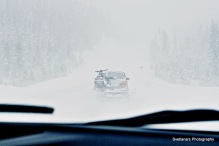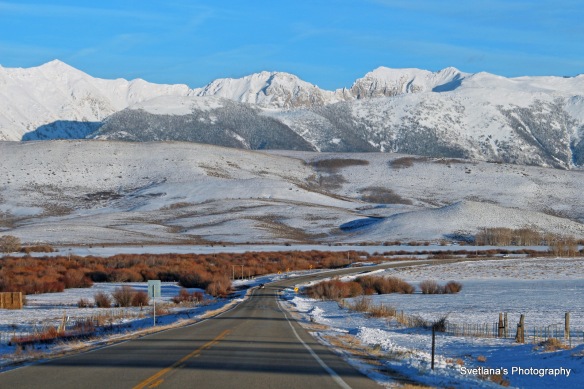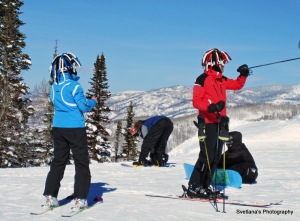 “Slow down!” I screamed at my husband when a gust of wind threw another clump of snow at our front window, obscuring the world outside our car. We were driving through a blizzard,
“Slow down!” I screamed at my husband when a gust of wind threw another clump of snow at our front window, obscuring the world outside our car. We were driving through a blizzard,  and my rhetorical question “Are we there, yet?” no longer reflected boredom but acquired a true urgency. Yet – finally! – our Subaru, loaded with ski clothes and equipment, and electronic gadgets (just the number of chargers is unbelievable!) reached Rabbit Ears Pass and began descending to Yampa Valley — the town of Steamboat Springs within it.
and my rhetorical question “Are we there, yet?” no longer reflected boredom but acquired a true urgency. Yet – finally! – our Subaru, loaded with ski clothes and equipment, and electronic gadgets (just the number of chargers is unbelievable!) reached Rabbit Ears Pass and began descending to Yampa Valley — the town of Steamboat Springs within it.
 Those who’ve never seen the Rocky Mountains in the winter should definitely rethink that (if you live outside the U.S., substitute a mountain region in your country :)), for, as far as I’m concerned, the austere beauty of snow-covered peaks and valleys is incomparable with any other natural setting. As for Steamboat Springs, its charm is in preserving the aura of a 19th century miners’ and ranchers’ town, where herds of cattle still run along its wide main drag to the rodeo grounds every 4th of July.
Those who’ve never seen the Rocky Mountains in the winter should definitely rethink that (if you live outside the U.S., substitute a mountain region in your country :)), for, as far as I’m concerned, the austere beauty of snow-covered peaks and valleys is incomparable with any other natural setting. As for Steamboat Springs, its charm is in preserving the aura of a 19th century miners’ and ranchers’ town, where herds of cattle still run along its wide main drag to the rodeo grounds every 4th of July.
Ranching, of course, is no longer the main occupation there. The thing that puts Steamboat Springs on the map now is outdoor activities: skiing in the winter (mostly downhill but Nordic skiing and snowshoeing as well); biking, whitewater rafting, and hiking  in the summer; and bathing in hot springs year round. Yet despite new fads and diets, there’re fancy restaurants there, too :)). Also, as it was in the past, the town is full of people with faces burnt by the sun, wind, and snow, although they are more likely to work in the ski village several miles away than on a ranch.
in the summer; and bathing in hot springs year round. Yet despite new fads and diets, there’re fancy restaurants there, too :)). Also, as it was in the past, the town is full of people with faces burnt by the sun, wind, and snow, although they are more likely to work in the ski village several miles away than on a ranch.
Since we first came to this area, it has grown considerably, especially the village: new houses and condos have popped up all over the valley, new inns and hotels brighten long winter nights with their perpetual Christmas lights, and shops and galleries have spread all over. Yet the village, bustling with activity by day, largely empties by night – some visitors stay put while many drive (or take a shuttle) to the town.
Our first morning started slowly — it’s hard to feel vigorous at 6900 feet when you have spent most of the year at 758. Besides, the blizzard was still raging, adding low visibility to our almost forgotten skiing abilities (when you ski once a year, your body forgets what it’s supposed to do). When, at the end of the day, a young receptionist asked us where we skied that day (easy runs only), our response didn’t impress him.
asked us where we skied that day (easy runs only), our response didn’t impress him.
“That sure is mellow,” He said condescendingly.
“We’ll see where you’ll be skiing where you’re our age!” I wanted to say, but my husband wouldn’t allow it. My husband is always like that. He never lies (what damage can a couple of white lies cause?), he never cheats on line calls in tennis (we’re not playing for money, so what if I call something out when it is in?!), and he never argues with sales clerks (recently, when he tried on crooked reading glasses, a clerk told him that his face was crooked, and my husband thought that was funny!?).
Our second day was even worse. Without much thought, we took the Storm Peak Express (should the name have told us something?) and found ourselves in whiteout so dense that we could hardly see each other two feet apart! Yet, as often happens in the mountains, the blizzard retreated as quickly as it came, and on our third morning, the bright sun illuminated the mountains and the surrounding valley, transforming everything into a sparkling-white playground. Seemingly overnight, our bodies found their perfect balance, our skis followed our every move (almost :)), and we no longer fought against the landscape but enjoyed the views, the fresh air, and the swift movements. We even had enough energy left for a night on the town: sizzling fajita and fried ice-cream in a Mexican restaurant, a stroll through local galleries, and a photo walk under the starry sky.
The next two days were picture-perfect as well: skiing under the gorgeous blue sky, stopping for lunch at a mountain lodge, and watching early afternoon shadows spread their blue wings on the snow — winter days in the mountains are short.
 At that point, my main task always is not to lose the sight of my husband. The thing is I have no sense of direction, and left to my own devices, I can easily end up on the other side of the mountain, alone. My husband, however, is always aware of his whereabouts. In our 16 years of skiing together, he lost that ability only once – after a fall that left him so disoriented that he asked me where the base village was. That scared me out of my wits — not because I couldn’t answer his question, but because it was a sign of something being very wrong with him. Lucky for me, his confusion didn’t last long, and after we got safely down, I made him buy a helmet, so he won’t scare me like that again.
At that point, my main task always is not to lose the sight of my husband. The thing is I have no sense of direction, and left to my own devices, I can easily end up on the other side of the mountain, alone. My husband, however, is always aware of his whereabouts. In our 16 years of skiing together, he lost that ability only once – after a fall that left him so disoriented that he asked me where the base village was. That scared me out of my wits — not because I couldn’t answer his question, but because it was a sign of something being very wrong with him. Lucky for me, his confusion didn’t last long, and after we got safely down, I made him buy a helmet, so he won’t scare me like that again.
Being directionally challenged, I, however, tend to ski first, ignoring (according to my husband) landscape markers and signs (trust me, I don’t – I just don’t see them!). Once in a while, I stop and wait for his directions, unless — in rare moments of absolute self-assurance, usually visiting me on our last run of the day — I take the wrong turn, and hear, “No-o-o! Not there!!!” from my long-suffering ski companion.
A week in the mountains always goes too fast, and soon we were preparing to go home (didn’t we just unpack everything?!). As usual, I thought — Would we enjoy a longer stay more or would it become monotonous? After all, you do the same things every day, and you don’t speak much to anybody. Well, you talk to people in shops and restaurants, and you have short conversations on the chairlift – this time we mostly ran into Texans, Australians (where it’s summer time :)), students, and several locals.
Also, how many more skiing years do we have left in us? Can’t be many. This might be as well, of course, since ski resorts with their gondolas and webs of chairlift are not exactly environmentally friendly. But would it be better if slim and energetic skiers sat around and watched TV instead? And what about the locals — those who live where they do because they enjoy the natural settings and the lifestyle it offers? They’re the nicest folks you meet, often finishing conversations with, “Thanks for coming here!” Without people like us, they wouldn’t have jobs!
Recently, I ran across a book “Conundrum,” by New Yorker David Owen. According to Owens, the green movement has everything wrong. It’s not the fuel-efficient cars that will save the environment but people who don’t drive at all. We should make our cities livable, so their residents won’t need to drive anywhere. I see his point. Yet would America have been discovered if Columbus had stayed put? And if nobody travels to the National Parks, what will that do to people’s understanding of nature and sense of wonder? Not to mention those who live near the parks.
Don’t take me wrong. I’m not trying to solve any social problems here. I’m just wondering :).




Svetlana, thanks for the vibrant and picturesque journey back to Steamboat. Haven’t been there in a long time, but your descriptions and images bring back fond memories!
LikeLike
Thank you very much! I really like that small town, and I hope that I managed to convey that in my post 🙂
LikeLike
Lovely! I think you’d better keep skiing–till you drop, at least. MB
LikeLike
Thank you, Mary Beth!
LikeLike
Sounds like very nice vacation! Worth driving! And I am glad you are safe back.
Zoia
LikeLike
Thank you, Zoia!
LikeLike